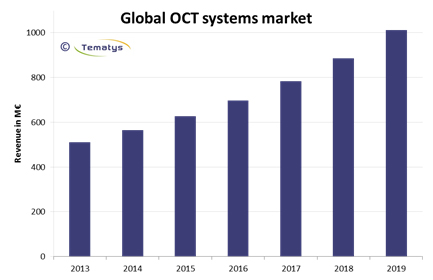Despite the apparent saturation of optical coherence tomography systems in the ophthalmology markets of developed countries, the distinct OCT market for healthcare and life science sectors is still expected to grow from around €500 million in 2013 to around €1b in 2019. This is one of the conclusions of a new market sector report from analyst company Tematys, Paris, France.

The report, Optical Coherence Tomography for Healthcare and Life Science: Technology and Market Trends, available from September 30, says that there will be “strong demand from new biomedical applications, continuous development of innovative OCT technologies, as well as strong demand from developing countries, which will drive the OCT market growth.” The full price of the report will be €3990, but early pre-orders (before September 30) will save €500.
Tematys continues, “According to our study, as OCT addresses global public health issues such as non-melanoma skin cancer, diabetic retinopathy, age-related macular disease, cardiovascular disease, Barett's esophagus, prostate cancer, and more, it is expected to be applied to medical applications outside ophthalmology.
“There is a huge need for label-free, non-invasive, in vivo imaging techniques for the diagnosis and monitoring of these pathologies that OCT can answer. Moreover the demand from developing countries such as China or India for such medical equipment is increasingly urgent.”
New approaches to OCT
To support the shift towards these new applications and geographic markets, Tematys says its study shows that further development of innovative technologies is necessary. Several functional OCT methods such as polarization sensitive OCT, Doppler OCT or OCT combined with fluorescence are being investigated to provide quantitative information and improve the diagnosis performance.
Further R&D efforts are needed to develop the performance and reduce the size of components and sub-systems for the newer OCT appliocations. Tematys concludes that the trend is heading towards greater miniaturization with the use of photonic integrated circuits. The report states, “The aim here is to enable the manufacturing of compact, low cost and portable OCT systems to reach applications at the dermatologist or the dentist's office, for example.”





